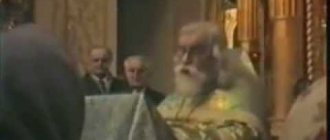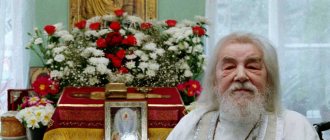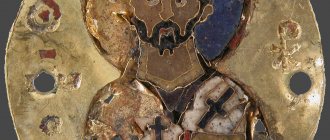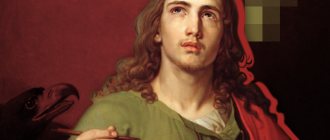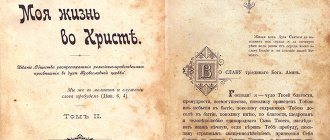Biography of John Climacus
The Righteous John was born in 570 into the family of Xenophon and Mary. At the age of 16 he came to the Sinai monastery, where spiritual father Martyrius became a mentor. After 4 years of ascetic labors, he became a monk.
For 20 years the monk was in obedience to his mentor, and when he died, he went into the desert. Here he spent forty years. Accompanied his life:
fasting and silence; tears and prayers.
In his work, he said that a tear washes away all evil spirits. The power of his righteous prayers is evidenced by an event that happened to his disciple.
According to John's instructions, the disciple Moses carried soil into the garden. When he was tired, he sat down under a cliff and fell asleep. Righteous John lay down and dozed off, but the elder woke him up and said that Moses was in danger. Then the mentor began to read a prayer. When the disciple returned, the spiritual master asked if anything bad had happened to him. He said that during his sleep the voice of his mentor called him. Moses quickly got up and walked, and behind him a tall boulder fell onto the place where he was sleeping.
John's lifestyle consisted of moderate fasting and normal sleep. He did not spend all night in intense vigil to keep his mind clear. In his opinion, humility is the main quality for God; the Lord gave him wisdom and the power of miracles.
John had a discerning mind and lovingly taught those who turned to him. But envious people talked about his verbosity, which testifies to pride. Then the righteous man took a vow of silence so as not to give reasons for condemnation. These people later realized their mistake, as they were deprived of spiritual food and conversations with him.
Dear brothers and sisters! We invite you to visit the unique resource https://www.slovo-pomoshi.ru/. With its help, you can convey your aspirations to St. Petersburg churches, chapels, monasteries, and also contact the righteous at the place of their burial. We will write a note ourselves, take it to the temple and send you a photo report by email. Turning to God with the help of prayers has helped many people overcome grief, regain health and the joy of worldly life.
Useful articles:
God - we can’t scold!
God - we can’t scold! Here are examples from life about people who dared to raise their dirty hands and filthy tongues against God and the Church. When a church was broken in the village of Selyavny, Voronezh region, the chairman of the village council and two of his assistants smashed a unique huge... Read more
We often grumble: “Why do I have such misfortunes?”
We often grumble: - Why do I have such misfortunes? And why do the Mother of God have seven wounds (sorrows) like this? If every day you make at least one bow to the Mother of God, she will not let you go, she will take you under her protection and bring you to the Kingdom of Heaven. If you offended your mother and she cursed you or... Read more
FOR ALL MEN READ: A letter from a man who has been married for 30 years.
The sailboat freezes helplessly without wind in its sails. The car stalls without gasoline. And even strong women run out of strength. Peace in the family is incomparably better than stupid male justice. Having lived a married life for almost 30 years, I began to realize that women are a friend... Read more
“Parental curses are very powerful.”
Know that the curse, even (simple) parental indignation, is very powerful. And even if the parents did not curse their children, but simply became indignant because of them, then the children do not have a single bright day in their lives: their whole life is one continuous torment. Then such de... Read more
Must read: The Zhirovitsk Icon: How it helps and what to ask for
The fame of his holiness reached distant places from the cave where John retired. They came to him with the hope of receiving words of consolation and hope of salvation. After 40 years of ascetic labors, the monk was elected abbot of the Sinai Monastery. John Climacus led the monastery for 4 years.
Solitary life
19 years after taking monastic vows (according to other estimates, at the age of nineteen), after the death of his confessor, John chose the Fola Valley, located at the foot of Mount Sinai, as a place for his exploits.
Here he devoted himself to silence, unceasing prayers, strict fasting, vigil (he slept only enough so as not to lose his sanity through excessive wakefulness), literary creativity and other works. He devoted part of his time to cultivating the land and tending to the vegetable garden that brought food to the table.
According to the chronicler, John remained in silent hermitage for about forty years, burning with jealousy and blessed spiritual fire, without wandering from place to place (except for the case of visiting the Egyptian lands). He overcame idleness and laziness with the help of God and constant remembrance of the coming Judgment.
The miracle of deliverance from death of the ascetic Moses, performed through the prayers of St. John, dates back to this period of life.
At one time, Moses, having secured the blessing of the elders, begged John to take him into his obedience and disciple. One day, while working on behalf of his teacher to fertilize the soil for the garden, Moses, exhausted from the hot heat, fell fast asleep. At this time John was also dozing. And then he saw a vision: the Graceful Man reproached him and noted that while he was slumbering, Moses was in trouble. John, awakened by the appearance of the Man, immediately jumped up and began to pray. In the evening, returning from work, Moses told him that when he fell asleep, he was almost crushed by a huge stone, but he (Moses) managed to jump away at the moment when he suddenly imagined that John was calling him.
Icon "John Climacus, George and Blaise"
The famous icon “John Climacus, George and Blasius” was painted by an unknown Novgorod author in the 13th century, and is currently kept in the State Russian Museum in St. Petersburg. It depicts three figures - John Climacus, the soldier Great Martyr George and Bishop Blasius. The noticeably towering figure of John and its central place in the composition symbolize the enormous contribution of the Reverend to the knowledge of the truth of the Teaching.
The severity and expressiveness of the images of the icon “John Climacus, George and Blasius” remind believers that the work of salvation requires dedication, fortitude and willpower.
Temples
Extremely modest during his lifetime, Rev. Even after his death, John was not honored with a large number of churches consecrated in his honor. In Russia now there are no more than 15-20 churches dedicated to the saint, including chapels. The most famous:
- "Ivan the Great" in the Moscow Kremlin.
The first temple on this site dates back to the 14th century; it was built during the reign of Prince Ivan Kalita. At the beginning of the 16th century. the church was rebuilt by Italian craftsmen. A high bell tower was built. It received its modern appearance in the 17th century. under Tsar Boris Godunov; Architectural ensemble of the Ivan the Great Bell Tower - Church of St. John at the Moscow Theological Academy and Seminary. The temple is located in the seminary building in the Trinity-Sergius Lavra. It was built at the end of the 19th century. as a house church at the hospital located in this building. In 1932 the temple was closed, and in 1989 services resumed there;
- Church of St. John in the Donskoy Monastery in Moscow (built at the end of the 19th century). The temple, like the monastery, was opened after the devastation of the Soviet years.
A number of churches of St. John the Climacus are closed, destroyed during the Soviet years and have not been restored to this day. Among them:
- the gate church of the Kirillo-Belozersky Monastery, built at the expense of the children of Ivan the Terrible, John and Theodore. The main altar of the temple was dedicated to the patron saint of the eldest son, Ivan;
- wooden church of St. John in Tomsk, built around 1912. and closed after 1917. The temple building was rebuilt after the revolution, now there are living quarters.
Several churches of the monk have been opened in recent years:
- in Smolensk a small church was built in 2014;
- in the village In Kurovka, Moscow region, in 1996-2000, the St. John's Church of the local Edinoverie community was erected.
“The Ladder” is the main work of St. John Climacus
The Monk John Climacus called his main creation, created at the request of the Raphael monks, “Ladder” (Ladder, Ladder of Paradise or spiritual tablets). He explained this name this way:
“I built a ladder of ascent... from the earthly to the holy... in the image of the thirty years of the Lord’s coming of age, significantly I built a ladder of 30 degrees, along which, having reached the Lord’s age, we will find ourselves righteous and safe from falling.” Despite the fact that it is intended mainly for monks, lay people seeking spiritual improvement can also read it.”
John Climacus “The Ladder”, manuscript 1334.
"The Ladder" is the main work of St. John. It is dedicated to the spiritual improvement of man through asceticism. Photo: upload.wikimedia.org In “The Ladder,” St. John combined the spiritual and ascetic traditions of Egyptian monasteries. In The Ladder, St. John combined the spiritual and ascetic traditions of Egyptian monasteries.
The book contains 30 conversations about 30 different stages of spiritual ascent to perfection. It was written in the middle of the 6th century at the request of John, abbot of the Raifa monastery. The image of the “Ladder” is borrowed from the Bible, which describes a vision of a Ladder along which angels ascend (Gen. 28:12).
“The Ladder” contains 30 conversations about the 30 stages of spiritual development.
The book belongs to the genre of spiritual ascetic literature. Its goal is to tell us that achieving salvation requires difficult self-sacrifice and intense feats from a person.
The idea contained in the “Ladder” presupposes, firstly, the cleansing of sinful impurity, the eradication of vices and passions in the old man; secondly, the restoration of the image of God in man. The basis of such spiritual improvement is the following line from Holy Scripture: “The Kingdom of Heaven is taken by force, and those who use force take it by force (Matthew 11:12).
Quotes
The sayings of John Climacus are varied and apply to both monks and laity.
About God
“Otherwise is God’s providence; another - God's help; other – storage; another is the mercy of God; and another - consolation. God's providence extends to every creature. God's help is given only to the faithful. The protection of God is upon those who are truly faithful and who are truly faithful. Those who work with God are honored with the mercy of God; and comforts belong to those who love Him.”
“Consecrate the firstfruits of your day to the Lord; for to whomever you give them first, him they will be.”
About prayer
“When you remain in prayer for a long time and do not see fruit, do not say: I have gained nothing. For the very stay in prayer is already an acquisition.”
About thoughts during prayer
“Do not grieve when you are plundered by thoughts, but be complacent and constantly call your mind to attention; for it is characteristic of one Angel to never be plundered by thoughts.”
About the post
“Do not think that you cannot fall because of abstinence; for one, even though he ate nothing, was cast out of heaven.”
About repentance and humility
“God judges repentance not according to the amount of work, but according to the degree of humility”
“Before our fall, demons present God to us as loving, but after our fall as cruel.”
“If from this passion (pride) alone someone fell from heaven, then one must investigate whether it is not possible to ascend to heaven through humility and without other virtues?”
About passions
“Often, when we perform acts of virtue, we secretly fulfill the passions intertwined with them. For example, gluttony is intertwined with love of love, fornication with love, deceit with reasoning, cunning with wisdom, subtle guile, slowness and laziness, bickering, self-indulgence and disobedience with meekness, the arrogance of teaching with silence, exaltation with joy, with hope - weakening, with love - again condemnation of your neighbor, with silence - despondency and laziness, with purity - a feeling of grief, with humility - insolence. Vanity clings to all these virtues.”
“It is a shame to be vain of other people’s jewelry, and it is extreme madness to be proud of God’s gifts.”
About the “iron” Isidore
The author of “The Ladder” not only teaches the reader, but also instructs him with examples of monastic life and deeds. Here is one such story, about the monk Isidore.
“A certain man named Isidore, from the princes of the city of Alexandria, retired to this monastery. This all-venerable shepherd, having received him, noticed that he was very cunning, stern, angry and proud. Therefore, this wisest father attempts to overcome the demonic cunning with human invention and says to Isidore: “If you have truly decided to take on the yoke of Christ, then I want you to first of all learn obedience.” Isidore answered him: “Like iron to a blacksmith, I submit myself to you, Holy Father, in obedience.”
Then the great father immediately assigns a teaching feat to this iron Isidore and says: “I want you, true brother, to stand at the gates of the monastery and bow to the ground to every person entering and leaving, saying: “Pray for me, father, for I am possessed by an evil spirit.” "
Isidore obeyed his father like an Angel of the Lord. When he spent seven years in this feat and came to the deepest humility and tenderness, then the ever-memorable father, after seven years of legal trial and Isidore’s unparalleled patience, wished him, as the most worthy, to be numbered among the brethren and honored with ordination. But he begged the shepherd a lot to be allowed to finish his feat there and in the same way, vaguely hinting with these words that his death was approaching and that the Lord was calling him to himself, which came true...
I asked this great Isidore, when he was still alive: what was his mind doing while he was at the gate? This venerable one, wanting to benefit me, did not hide this from me. “At first,” he said, “I thought that I had sold myself into slavery for my sins, and therefore with all grief, self-violence and bloody compulsion I bowed. After the year had passed, my heart no longer felt sorrow, expecting a reward for patience from the Lord Himself. When another year had passed, in my heart I began to consider myself unworthy of staying in the monastery, and seeing the fathers, and looking at their faces, and communion of the Holy Mysteries, and, with my eyes lowered, and my thoughts even lower, I sincerely asked those entering and those who come forth to pray for me” (“The Ladder”, word 4, 23–24).
Life path
In Holy Rus', great ascetics secluded themselves in forests and caves, took a vow of silence and stylite life. Conceit or pride can ruin a monk's many years of work in the blink of an eye. However, many were able to overcome temptations and receive eternal life. And all this thanks to the Lord and His monastic ascetics, such as St. John Climacus, whose creation “The Ladder” guides all Christians to true spiritual life.
Venerable John Climacus
Little is known about the early life of this ascetic. John was born into the family of pious Christians Xenophon and Mary between 525-595. In the sixth century, the persecution of Christians ceased, which allowed a serious young man beyond his years, after a secular education, to go to the Sinai monastery to study the spiritual foundations of Christianity. Abba Martyrius became the mentor for the sixteen-year-old teenager. Four years later, John took monastic vows on the holy mountain. He faithfully carried out obedience under Abba Martirios.
Lives of other saints:
Life of the Venerable John Cassian the RomanLife of the Venerable Elder Silouan of AthosLife of the Saint Venerable Kuksha of Odessa
After his death, John takes a vow of silence and retires to a deserted place. The saint spends more than forty years in fasting and constant prayer.
He followed all the instructions according to the rules and led a moderate spiritual life. He devoted very little time to sleep so that his mind would not become clouded from constant wakefulness. Writing various books on the topic of spiritual life became a consolation for him in times of despondency. Thanks to his modest life, people and brethren of the monastery came to him. The monks decided to elect John as abbot of the monastery.
The prophecies of the fathers who predicted the abbess for John in his early youth came true. Over the next four years, the monk zealously obeyed the abbot of the monastery.
Writing "The Ladder"
Knowing about the saint’s enormous spiritual experience, the brethren asked him to write a guide for monastic life. This work was called “The Ladder”. The author himself explained that this title reflects the essence of the manual: “After all, this book is a ladder along which everyone can climb to the gates of heaven.”
Icon "Ladder of John the Climacus"
There are a total of thirty steps in it, which will mark the thirty years of the Lord’s coming of age.
Important! It is noteworthy that this book is also suitable for ordinary lay people. Reverend Sergius of Radonezh and Joseph of Volokolamsk recommended this book as the best guide to saving your soul.
The end of the earthly journey
Towards the end of his earthly life, John received the gift of miracles. Before his death, he handed over the abbess to Bishop George, and he himself retired to a deserted place to pray.
More interesting articles about Orthodoxy:
Does a person have a soul? Do animals have a soul? Why does the soul hurt and want to cry?
According to legend, John Climacus reposed in the Lord on March 30, 606 at the age of 80. Particles of the saint's relics are kept in various Greek monasteries:
monastery of Kehrovouniou (Tinos island); monastery of the Virgin Mary (Samos island); monastery of the Virgin Mary (Panagia Tourliani, Mykonos island). Interesting! The next abbot, realizing his powerlessness in managing the monastery, asked Saint John to take him with him. John promised that he would ask God about this. Ten months later, John’s protege peacefully departed to the Lord.
The Church honors the memory of St. John Climacus on April 12, as well as on the fourth Sunday of Lent.
Preliminary information
He is revered by the Holy Church among the outstanding co-founders of monasticism.
The estimated period of his life is determined by the 6th - 7th centuries. Despite the widespread veneration of this ascetic among believers, and especially among monastics, the biographical details of his life have not reached us.
He is known to a wide circle of Christians, first of all, as the compiler of an authoritative and very popular monument of ascetic literature: “The Ladder...”. It would not be an exaggeration to say that this work was a reference book for many famous ascetics.
According to some historical sources, John Climacus was the son of Saint Xenophon. The estimated place of his birth is identified as Constantinople.
Based on the evidence that has reached our time, on the basis of which it is known that before entering the monastic path, John was trained in external wisdom, and, therefore, managed to receive a proper secular education, it is appropriate to assume that he was born and raised in a financially secure family.
Even at a young age, John preferred a harsh, ascetic life to the joys of the world. As a sixteen-year-old youth, he took monastic vows on Mount Sinai.
This biblical place has attracted ascetics since the 3rd century. It is believed that during the life of Climacus, at least several dozen hermits were saved in that territory.
Having renounced proud ambitions, vanity and self-indulgence, John entrusted his spiritual education to one of the most skillful and experienced Sinai teachers, the spirit-bearing Abba Martyrios.
Despite his enviable education, while learning the basics of monastic wisdom, John did not exalt himself with learning, was modest and simple in his interactions with his neighbors, and was obedient to his confessor in everything.
Following the advice of his mentor, Abba Martyrius, and fulfilling his instructions, he did it so diligently and selflessly, as if he obeyed not a person, but the Heavenly King Himself who commanded through him.
Long before John was given leadership over the monks, God revealed his future glory through His saints. So, one day Anastasius the Great, known for his virtue, called John the abbot of Sinai (although at that point in time he was still far from being an abbot). Another time, John Savvait, an ascetic from the Guda desert, washed the feet of John Climacus, as if he were already an abbot.
Icon of John Climacus
Along with the “Ladder”, individual icons with the face of John the Climacus himself also appeared.
As a rule, the saint was depicted in monastic robes with a doll on his head and a scroll or book in his hands. Sometimes John Climacus was represented on the icon not alone, but surrounded by other saints - George and Blaise.
Prayers
Troparion, tone 4
[4]
Like the Divine ladder, I found, like John, / your Divine virtues, / leading us to Heaven: / virtues, for you were the imagination./ / Therefore pray to Christ God, that he may save our souls
.
Kontakion, tone 1
(Similar to: Face of an Angel:) [5]
The fruits of the ever-blooming, / from your book bearing teachings, wise, / delight the hearts, with sobriety of those who listen, blessed: / for there is a ladder, leading souls / from earth to Heaven and abiding glory you// those who honor you with faith
. [6]
In Troparion, Hellenic, voice 3
(from Greek Menaion) [7]
Having established the divine ladder for everyone,/ the art of your words,/ you appeared to the monastics as a mentor,/ from the deeds, John, of purification,/ raising to contemplation the radiance./ Reverend Father,/ Christ Bo We prayed // to grant us great mercy
.
Ladder
The abbot of Raifa turned to him with a request to draw up instructions for spiritual perfection. The monk was distinguished by modesty, such a proposal embarrassed him. But duty forced creation to begin. The book “The Ladder” by John Climacus is recommendations for:
- cleansing of sins;
- getting rid of vices;
- restoration of unity with the Lord.
The best article for you, go to: The Feodorovskaya icon: how it helps, what to pray for and where it is located
The manual was originally written for monks. Theodore the Studite, Sergius of Radonezh, Joseph of Volokolamsk and others were guided by the book for instructions.
One of the themes of “The Ladder” is the eradication of pride. Quotes from John Climacus suggest that one should not boast of every virtue. Talking about fasting is vanity, hiding the same thing. Whoever exalts himself with intelligence, education and other qualities will never achieve the highest gifts. The Lord pacifies the vain, sending them dishonor.

